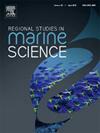Warming events and their causes at the Bering Sea section B in summer of 1999–2019
IF 2.1
4区 环境科学与生态学
Q3 ECOLOGY
引用次数: 0
Abstract
Based on hydrological data for the Bering Sea from 1999 to 2019 during the Chinese National Arctic Research Expeditions (CHINAREs), along with oceanographic and meteorological data from the National Centers for Environmental Information (NCEI) and the European Centre for Medium-Range Weather Forecasts (ECMWF), we investigated trends in summer at the Bering Sea section B over the past 20 years and their underlying causes. The results revealed a pronounced rise in temperature at the Bering Sea section B in 2003, 2014, 2016, 2018, and 2019, suggesting a shift towards a new phase of warmth starting in 2014. In warm years (2003, 2014, 2016, 2018, and 2019), the mean maximum temperature in the upper layer in the basin north of 57°N and on the continental shelf were roughly 2.7 °C, 2.6 °C higher than that in cold years (1999, 2008, 2010, and 2012). Additionally, the mean minimum temperature of the cold water in the middle layer in the basin was roughly 0.7 °C higher in the warm years compared to the cold years. This difference between the warm and cold years was evident in the heat content: the average heat content in the upper to middle layers in the basin north of 57°N and on the continental shelf were about 1.2 and 0.9 GJ/m2 higher, respectively, in the warm years than the cold years. However, there was a modest warming trend in the basin south of 57°N, and the temperature in the mid-layer on the continental shelf showed year-to-year stability, in contrast to the significant warming observed elsewhere. Further study suggested that temperature fluctuation in the basin was closely tied to seasonal 2-m air temperature. In addition, the southern basin, divided at 57°N, experienced larger positive or negative anomalous wind stress curl compared to the northern basin. This discrepancy resulted in differing causes of temperature variation between the two regions. Temperature change in the upper layer on the continental shelf was attributed to an increase in cumulative net heat flux resulting from reduced sea ice, while the temperature in the middle layer on the continental shelf was limited by the enhanced density gradient between the upper and middle layer caused by melt ice, preventing significant warming. Overall, the thermal state for the Bering Sea section B was influenced by a combination of factors, including net heat flux, sea ice, and atmospheric conditions, contributing to the year-to-year variation characterized by alternating cold and warm regimes.
1999-2019 年夏季白令海 B 区变暖事件及其原因
基于中国国家北极科学考察(CHINAREs)期间白令海 1999 年至 2019 年的水文数据,以及美国国家环境信息中心(NCEI)和欧洲中期天气预报中心(ECMWF)的海洋和气象数据,我们研究了白令海 B 段过去 20 年的夏季变化趋势及其内在原因。结果显示,白令海 B 段在 2003 年、2014 年、2016 年、2018 年和 2019 年的气温明显上升,这表明从 2014 年开始,白令海进入了一个新的温暖阶段。在暖年(2003、2014、2016、2018 和 2019 年),北纬 57°以北海盆和大陆架上层的平均最高气温约为 2.7 ℃,比冷年(1999、2008、2010 和 2012 年)高出 2.6 ℃。此外,暖年与冷年相比,海盆中层冷水的平均最低温度高出约 0.7 ℃。暖年与冷年之间的这种差异在热含量方面也很明显:暖年北纬 57°以北海盆中上层和大陆架的平均热含量分别比冷年高出约 1.2 和 0.9 千兆焦/平方米。然而,北纬 57 度以南海盆的升温趋势并不明显,大陆架中层的温度呈现逐年稳定的态势,这与其他地区观测到的显著升温形成鲜明对比。进一步研究表明,海盆温度波动与季节性 2 米气温密切相关。此外,与北部海盆相比,以北纬 57 度为分界线的南部海盆经历了更大的正或负异常风应力卷曲。这种差异导致两个地区温度变化的原因不同。大陆架上层的温度变化归因于海冰减少导致累积净热流量增加,而大陆架中层的温度变化则受到融冰导致中上层密度梯度增大的限制,无法显著升温。总体而言,白令海 B 海段的热状态受净热通量、海冰和大气条件等综合因素的影响,造成了冷暖交替的年际变化特征。
本文章由计算机程序翻译,如有差异,请以英文原文为准。
求助全文
约1分钟内获得全文
求助全文
来源期刊

Regional Studies in Marine Science
Agricultural and Biological Sciences-Ecology, Evolution, Behavior and Systematics
CiteScore
3.90
自引率
4.80%
发文量
336
审稿时长
69 days
期刊介绍:
REGIONAL STUDIES IN MARINE SCIENCE will publish scientifically sound papers on regional aspects of maritime and marine resources in estuaries, coastal zones, continental shelf, the seas and oceans.
 求助内容:
求助内容: 应助结果提醒方式:
应助结果提醒方式:


